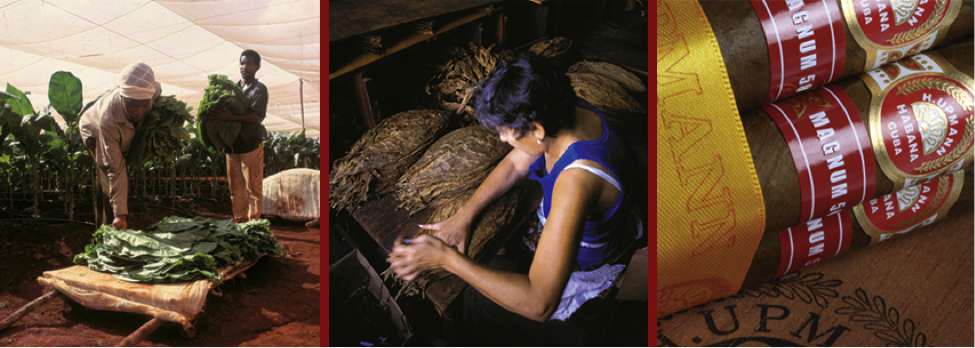Cuban Tobacco and Habanos Term Glossary
When it comes to speaking the language of Habanos (Havana cigars), the words are as romantic as they are foreign. Perilla, fortaleza, capa — even the basic jargon evokes a frisson of excitement, calling to mind swaying palm trees, soft rhumba songs floating through a curing barn’s gabled roof and a singularly vibrant tradition where artisans still hand-create these products of beauty and prestige.
While the language of Habanos is undeniably poetic, it can also be incredibly intimidating, particularly for those new to the category. However, with a little familiarity and practice, there is no reason why words like tripa and bonche shouldn’t become second nature to any cigar lover. Below is a glossary of the most essential Habano terms.
Anilla: Cigar ring or a band around a cigar
Acopio y Beneficio: The process of gathering and enriching tobacco leaves after harvest until they are ready to be placed in bales to mature
Aporque: The action of piling up earth around the tobacco plant in order to strengthen the roots
Barajita: The department of the factory where assembling the tobacco leaves for blending takes place
Bofetón: The protective leaf of paper inside the cigar box, decorated to complement the “vista”
Bonche: The cylindrical bunch of leaves that is formed when the filler leaves are rolled together and wrapped with a binder leaf
Boquilla: The foot of the cigar
Cajuela: Or “mini-rodero” – the open-fronted, lidless container in which rolled cigars are transported within the factory
Cajón: The wooden Habanos box
Cajón Habilitado: The dressed Habanos box
Caja: The master carton case containing a standard number of boxes, jars or carton displays of Habanos
Capa: The outer leaf of a cigar
Capote: Binder – The leaf used to bind all the tobacco, selected from the largest and finest volado leaves grown on the lower part of the plant
Casa de Tabaco: Translates to “Tobacco House,” the barn on a plantation where the tobacco leaves are cured
Casquillo: A cylindrical punch used to cut a small section from the wrapper to complete the cap
Catadores: Spanish for “taster,” factory workers who ensure quality control by tasting batches of finished cigars daily
Cedros: Cedars used to wrap cigars as well as separate rows in cigar boxes
Centro Fino: Leaves located in the middle of the tobacco plant
Cepo: Instrument used to check the ring gauge and length of a finished cigar
Chaveta: Crescent-shaped tool used to cut tobacco leaves while rolling
Cigarro: Though in Cuba this word means cigarettes, in other Hispanic countries “cigarro” means cigar
Claro: The description of a dark brown colored wrapper on a finished cigar
Corona: Sometimes a factory vitola name for many Habanos. Also, the top leaf in a tobacco plant
Costero: The color strip on the short sides of the dressed Habanos box, often indicating the size of the cigar
Cuje: The wooden pole used to hang the leaves sewn in pairs in the Casa de Tabaco
Curación: Curing. The process of drying out the tobacco leaves that occurs in the curing barn or Casa de Tabaco
Cubatabaco: Cuban government-owned company that commercialized Habanos before Habanos S.A. took over the business in 1994. The name can still be seen in a hot seal on the bottom of Habanos boxes produced before 1994
Cubierta: The image on the top of the dressed Habanos box
Desbotonar: The process of removing the top bud of the tobacco plants to concentrate growth on the development of additional leaves
Deshije: Removing the side shoots (“hijos”) after the removal of the top bud on a tobacco plant
Despalillo: The Stripping House where the stem of selected binder and filler leaves is removed and where the second and the third fermentation of the seco, ligero and medio tiempo leaves occurs
Despalilladoras: The women who strip the binders and fillers at the stripping houses and the wrappers in the factories
D.O.P. Denominación de Origen Protegida (Protected Denomination of Origin)
Edición Limitada: Limited Edition Habanos produced with filler, binders and wrappers aged at least two years. The boxes carry an extra black and gold seal indicating that they contained a limited edition as well as the year in which they were released. Each cigar is dressed with an extra band with the same information
Ensarte: The sewing of leaves together in pairs prior to placing them on cujes in the traditional curing barn. Also, used as an alternative word to describe the leaf-by-leaf harvesting method.
Escaparate: The conditioning room where cigars are stored at 16 to 18 degrees Celsius and between 65% and 70% humidity to recover from their rigorous creation
Escogida: The Sorting House, where all leaves are classified wrapper leaves are fermented
Escogedores: Color graders who work in pairs to color-match the cigars in a box. They are among the most senior workers in the factory
Festival del Habano: Habanos Festival is the foremost Habanos event. Organized for the first time in 1999, the festival takes place every year during the last week in February. Habanos aficionados from all over the world meet in Cuba to share experiences, taste new Habanos, visit factories and vegas finas de primera and participate in a gala dinner, the auction of unique artistic cigar humidors, a Habanos sommelier contest, seminars and other events surrounding Habanos
Figurado: A fancy cigar with an irregular shape pointed at one end (or in the case of double-figurados, pointed at both ends) and/or different ring gauge along its length
Filete: The decorative strip that seals the lid´s hinge in the dressed Habanos box
Fortaleza: The cigar’s strength and robustness. Fortaleza 1,2,3 and 4 are synonyms for volado, seco, ligero and medio tiempo, respectively.
Galera: The factory workshop where cigars are hand rolled
Gavilla: Bunches of graded tobacco leaves held together by string tied by their stems for handling
Goma: Tasteless and odorless vegetable gum, usually tragacanth, used by torcedores to secure the wrapper leaf and cap on a finished cigar
Gran Reserva: A specific term employed only for Habanos whose fillers, binders and wrappers have been aged for a minimum of five years before the cigars were made
Habanos S.A.: Cuban company that took over the Habanos business from Cubatabaco. It is 50% government owned and 50% Imperial Tobacco owned
Habanosommelier: An employee in a bar or restaurant skilled in the art of selecting and serving Habanos as well as pairing Habanos with drinks and food. A contest to find the world’s best Habanos sommelier is staged as part of the Festival del Habano each year.
Habilitaciones: The colorful dressings used to decorate the traditional labeled boxes of Habanos
Hecho En Cuba: A term that means “Made in Cuba”
Larguero: The color strip on the long sides of the Habanos dressed box, also often indicating the size of the cigars
Lector de Tabaquería: Professional readers who read books, newspapers and other reading materials aloud to cigar rollers as they worked throughout the day
Libre de pie: Leaves located in the bottom part of the tobacco plant just above mañanita leaves
Ligada: Blend of Habanos cigars
Ligador: The master blender in a Habanos factory
Ligero: The word translates literally to “light” but it is used to describe the filler leaves with Fortaleza 3. They are the dark leaves from the top of a tobacco plant, typically rich in flavor
Maduro: Spanish for “ripe,” a dark, almost black, colored cigar wrapper on finished cigar. The color can be achieved by a longer or more intense fermentation.
Mañanita: Leaves on the bottom of a tobacco plant, too small for Habanos
Media Rueda: Also known as a half-wheel, the Spanish word for a bundle of 50 Habanos tied into a bundle
Medio Tiempo: One of the tiempos or type of filler leaves; the two leaves with the most robust flavor cultivated from the very top of a sun grown tobacco plant. They are incredibly rare.
Mini Rodero: Or “cajuela” – the open-fronted, lidless container in which rolled cigars are transported within the factory
Moja: The process of moistening tobacco leaves
Pacas: Hessian bales in which binder and filler leaves are aged
Papeleta: A rectangular or oval seal on the short side of the box
Parejo: A cigar with straight, parallel sides
Perilla: The cigar’s head
Perilla con Apéndice: A head of a cigar with pig tail
Petaca: Small carton or metallic box of three or five cigars
Reserva: A specific term employed only for Habanos whose fillers, binders and wrappers have been aged for a minimum of three years before being taken to the factory for rolling. Every cigar carries a second black and silver band identifying that it is a Reserva.
Rodero: A large wooden box that shelters the delicate Habanos as they are moved throughout the factory
Seco: One of the tiempos or families of filler leaves; filler tobacco leaves taken from the middle of the plant, valued for their aroma
Sello de Garantía: Cuban Guarantee Seal introduced in 1889. This seal is a mark of distinction on every box of Habanos packaging to assure authenticity
Tabaco: Spanish for “tobacco,” but synonymous with “cigar” in Cuba
Tabaco Negro Cubano: The native Cuban Black Tobacco, directly descended from the plants first discovered by Columbus in 1492
Tabaco Torcido: Hand-made or machine-made cigar
Tabacuba: A state-owned corporation that manages the agricultural and manufacturing operations of the Cuban tobacco industry
Tabla: The wooden surface on which Torcedores roll cigars
Tapado: The term used to describe the method of growing tobacco for wrappers in the shade under a muslin cloth
Tapaclavo: A seal fixed over the nail that secures the lid of the dressed Habanos boxes
Tercio: A bale made from Yagua in which wrapper leaves are aged
Tiempos: Fortaleza – Different grades of filler leaves needed for various purposes required for blending the Habano.
Tiro: The draw of the cigar
Torcedor(a): Cigar roller
Totalmente a Mano: Fully handmade cigar
Tripa: Filler – The blend of two, three or four different types of tobacco leaves that form the heart of a Habano and dictate its flavor
Tripa Larga: Long-filler or filler that is made from full length tobacco leaves
Vegas Finas de Primera: First-class fields in plantations located in registered Cuban Tobacco Regions that are approved by the Cuban Tobacco Research Institute and the Regulatory Council to exclusively farm leaves for use in Habanos
Veguero: Cuban tobacco farmer
Vitola : A word with many meanings. In Cuba, it can refer to the shape of a cigar, a factory name or a commercial size name. In Spain it means a cigar band or ring. To some “vitola” has an almost spiritual meaning encapsulating every aspect of their cigar choice
Vista: A romantic pictorial celebration of the brand with historical images and notes in the inside the cover of the cigar box
Volado: One of the tiempos, or families, of filler leaves; cultivated from the bottom of the tobacco plant and valued for its mildness and flammability
Yagua: The loose part of the bark of the Royal Palm, Cuba’s national tree, which is used to make bales (or tercios) in which wrapper leaves are aged
Zafado: The gentle loosening of tobacco leaves after they have been unpacked in gavillas from bales


Comments